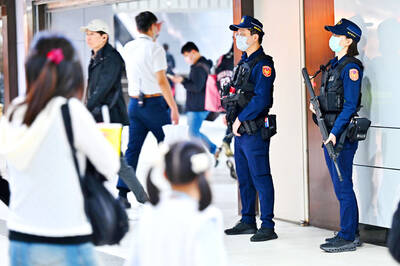A newly declassified US intelligence report claims that China is developing electromagnetic pulse (EMP) weapons for use in a future conflict with Taiwan.
EMP weapons can be used to emit a huge pulse of electromagnetic radiation that can knock out all electronics — particularly computers — over a widespread area.
The privately run National Security Archive in Washington has released the report, which was produced in 2005 by the US National Ground Intelligence Center.
The report speculates that Beijing might be trying to develop a capability to incapacitate Taiwan electronically without triggering a US nuclear retaliation.
Analysts believe that China could be planning to cause a massive low-altitude EMP burst over Taiwan in such a way that it would severely damage electronics in Taiwan — disabling weapons systems — but kill few people and not impact China.
The archive has gained access to a total of 2,300 US declassified intelligence papers, which it is making available under the title US Intelligence and China: Collection, Analysis and Covert Action.
The papers cover the period from 1945 until last year and include covert action operations by the US and Taiwan in the 1950s and 1960s aimed at weakening the Chinese Communist Party’s hold in China.
“For use against Taiwan, China could detonate at a much lower altitude — 30 to 40 kilometers — to confine the EMP effects to Taiwan and its immediate vicinity and minimize damage to electronics on the mainland,” the EMP report says.
Chinese military scientists are known to have discussed building low-yield EMP warheads, but the report says that “it is not known whether the Chinese have actually done so.”
It says that in addition to a specially built warhead, any low-yield strategic or tactical nuclear warhead could be used to create an EMP explosion.
“The DF-21 [Dong-Feng 21] medium-range ballistic missile has been mentioned as a platform for the EMP attack against Taiwan,” the report adds.
DF-21 missiles are two-stage, solid-propellant, single-warhead medium-range ballistic missiles that have been deployed since the early 1990s.
The US Department of Defense estimates that China has 60 to 80 DF-21s in service.
These missiles can carry nuclear or non-nuclear high-explosive warheads and when equipped for use as electronic weapons are part of China’s “trump card” or “assassin’s mace” arsenal and “are based on new technology that has been developed in high secrecy,” it says.
According to the declassified intelligence report, China has conducted animal experiments to ensure that EMP weapons used against Taiwan and “any vulnerable US aircraft carrier” that might be in the region would not push the US across the nuclear-response threshold by killing large numbers of people.
The report says that China’s EMP capability could be used as a surprise measure after an initial strike against Taiwan and also as a bluff to dissuade the US from defending Taiwan with a carrier strike group.
“The minimization of casualties on Taiwan is calculated to lessen the animosity among Taiwan’s population over forced reunification,” it adds.

TRAGEDY STRIKES TAIPEI: The suspect died after falling off a building after he threw smoke grenades into Taipei Main Station and went on a killing spree in Zhongshan A 27-year-old suspect allegedly threw smoke grenades in Taipei Main Station and then proceeded to Zhongshan MRT Station in a random killing spree that resulted in the death of the suspect and two other civilians, and seven injured, including one in critical condition, as of press time last night. The suspect, identified as a man surnamed Chang Wen (張文), allegedly began the attack at Taipei Main Station, the Taipei Fire Department said, adding that it received a report at 5:24pm that smoke grenades had been thrown in the station. One man in his 50s was rushed to hospital after a cardiac arrest

A car bomb killed a senior Russian general in southern Moscow yesterday morning, the latest high-profile army figure to be blown up in a blast that came just hours after Russian and Ukrainian delegates held separate talks in Miami on a plan to end the war. Kyiv has not commented on the incident, but Russian investigators said they were probing whether the blast was “linked” to “Ukrainian special forces.” The attack was similar to other assassinations of generals and pro-war figures that have either been claimed, or are widely believed to have been orchestrated, by Ukraine. Russian Lieutenant General Fanil Sarvarov, 56, head

SAFETY FIRST: Double the number of police were deployed at the Taipei Marathon, while other cities released plans to bolster public event safety Authorities across Taiwan have stepped up security measures ahead of Christmas and New Year events, following a knife and smoke bomb attack in Taipei on Friday that left four people dead and 11 injured. In a bid to prevent potential copycat incidents, police deployments have been expanded for large gatherings, transport hubs, and other crowded public spaces, according to official statements from police and city authorities. Taipei Mayor Chiang Wan-an (蔣萬安) said the city has “comprehensively raised security readiness” in crowded areas, increased police deployments with armed officers, and intensified patrols during weekends and nighttime hours. For large-scale events, security checkpoints and explosives

PUBLIC SAFETY: The premier said that security would be tightened in transport hubs, while President Lai commended the public for their bravery The government is to deploy more police, including rapid response units, in crowded public areas to ensure a swift response to any threats, President William Lai (賴清德) said yesterday after a knife attack killed three people and injured 11 in Taipei the previous day. Lai made the remarks following a briefing by the National Police Agency on the progress of the investigation, saying that the attack underscored the importance of cooperation in public security between the central and local governments. The attack unfolded in the early evening on Friday around Taipei Main Station’s M7 exit and later near the Taipei MRT’s Zhongshan